Test conditions
Tests of the HP ProLiant microserver were carried out by us under control of the fresh Microsoft Windows Home Server 2011 operating system (x64) which is based on Windows Server 2008 OS technologies. The Home Server 2011 system flatly refused to be installed on 1 Gbyte of system memory by which the microserver was completed by delivery (1 Gbyte of memory enters into a base set), having demanded for itself 2 Gbytes. Therefore we had to replace a memory level with twice more capacious and with it to carry out all tests.
First of all us productivity of the microserver will interest at work as network storage of files (and as disk space for performance by network users on the microserver of some tasks of a local network) at a various configuration of massifs of disks in the microserver. For this purpose on the complete disk Seagate Barracuda 7200.12 ST316318AS the those operating system, and three other disks in a basket as which the terabaytny Hitachi Deskstar E7K1000 HDE721010SAL330 models optimized for work in RAID acted was established, were united in these or those massifs — as means of a chipset (through the BIOS Setup menu of a payment of the microserver), and means of the most Windows operating system (on two following screenshots for an example the RAID array 5 of three disks, organized in the disk manager of OS is shown).
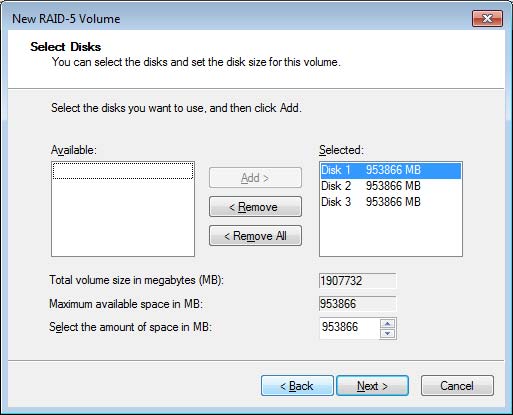
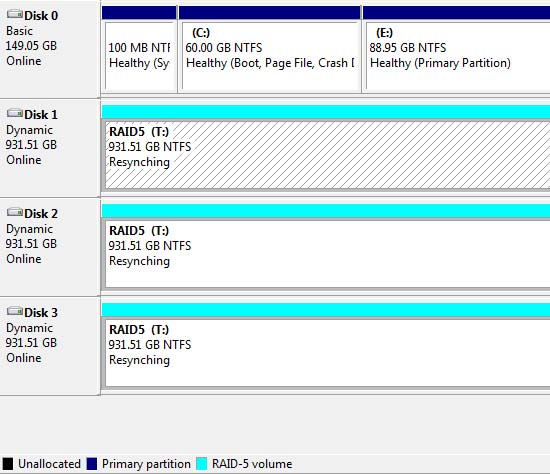
Following configurations participate in this comparison:
- hardware RAID 0 of 3 disks;
- hardware RAID 0 of 2 disks;
- hardware RAID 1 of 2 disks;
- single disk (AHCI mode);
- software RAID 0 of 3 disks;
- software RAID 1 of 2 disks;
- software RAID 5 of 3 disks.
Arrays are given in the same order on charts below. The JBOD mode in this case is provided by the elementary equivalent — a unit disk. Unfortunately, this chipset of AMD isn't trained in knowledge of the organization of arrays with monitoring of parity (RAID 5), as well as can't construct on one disk set at the same time two different arrays (we recall Intel Matrix RAID) that in case of the microserver could have a certain reason. Therefore these categories of disk arrays remain here only on a payoff to an operating system, and our tests of purely program arrays aren't deprived not so sense. By the way, if to recall "ready" "desktopny" NAS of a segment of SOHO, as a rule, not equipment rooms, namely program (by means of Linux) arrays of disks there are just used. Therefore it will be useful for us to learn, whether the "chipsetny" (pseudo-hardware) organization of arrays in this case will give any advantage before traditional software for inexpensive NAS.
The HP microserver was connected a patch cord directly to gigabit network port of the testing computer (in its quality more powerful machine on the basis of the Intel Xeon 3120 processor with a chipset of Intel P45 Express and 2 Gbytes of a random access memory under control of Windows XP appeared certainly) and from this computer test benchmarka on the network drive organized by means of the HP microserver were launched. Windows XP use in this case isn't accidental — under control of this OS now the majority of inexpensive client PCs at offices and at home too still works. And the more so, if the company saves means, buying HP Microserver, it hardly will be scalely spent for still expensive licenses of "Seven". Certainly, under Windows 7 results of some tests (from this NASPT) is noticeable above, but in others indexes cardinally below (see. the chart after that paragraph on NAS Synology DS710 example +), and this "bedlam" of results reflects, in particular, features of protocol implementation of SMB of different versions and more aggressive algorithms of caching of Windows 7 by network operation (and client places in its basis), but the microserver not researched in this review as that.
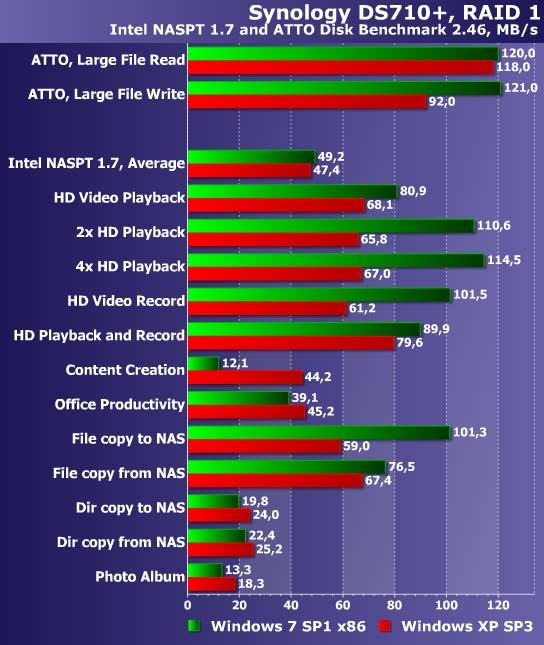
On the side of "client" the Realtek RTL8111DL network controler integrated into the motherboard on the bus PCI Express x1 for which the Jumbo Frame parameter was set on a maximum was used. For the HP microserver drivers from sites AMD and Broadcom for January, 2011 were used (drivers from a site HP, unfortunately, didn't differ freshness and variety; see a screenshot to [Increase] to [Increase]). The technique of this testing is actually identical to that that is used by the author when testing high-speed performance of network drives and NAS on the basis of Linux and so forth. So results can be compared directly. Here we emphasized two benchmark packages — ATTO Disk Benchmark 2.46 (tests for maximum speed of a read and write of large files big units of 64-2048 Kbytes) and Intel NAS Performance Toolkit 1.7.1 (tests according to 12 versatile scenarios of maintenance of NAS). All benchmarks were carried out 5 times, results averaged.
Tip: Please see the raid server data recovery
Results of tests of arrays
At first we will define, what maximum internal speed of a read and write of large files for arrays at the server. For this purpose directly on the microserver (connected to the monitor and the keypad) the ATTO Disk Benchmark test was launched. Results of this dough are given on the following chart.
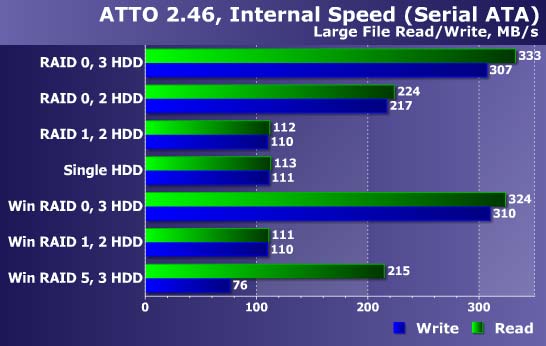
Here everything is natural: the line speed of arrays is proportional to number of the disks parallely participating in process (units of a read and write of files here are larger than a defoltny step of alternation of arrays in 64 Kbytes and nobody cancelled caching) — the speed trebled of rather single disk for the three-disk RAID, doubled — for RAID 5 and two-disk RAID 0 and equality with a single disk for simple "mirror" (RAID 1). However, speed of disk writing it is essential to RAID 5 (three times!) below, than when reading — it is the price for program обсчет XOR functions by means of the CPU in OS. For three-disk RAID 0 the line speed passes for 300 MB/s that more than some of gigabit Ethernet. However, and for "mirror" of speed of disks shall suffice for satisfaction of needs of the high speed network interface.
If now to launch the same test from other computer on the same disks/arrays of the microserver in the volume/folder shared mode (the network drive connected under Windows), results will be the following:
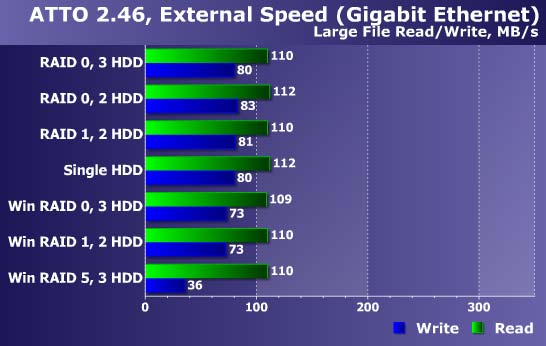
As we see, speed of reading files for all arrays is restricted to the network interface at level of 110 MB/s (that is close to a theoretical limit of possibilities of a gigabit Ethernet — 125 MB/s minus expenditures on transmission of service data). And here speed of record of files appears below — about 80 MB/s for the hardware arrays and slightly less — for program arrays. And for RAID 5 it fell already to 36 MB/s against twice bigger index "in" the microserver. If to start with these data, it is possible to expect, as on more difficult loadings, than a read and write of big files in the ideal conditions, all arrays, except RAID 5, will show the close high-speed performance by network operation. For an assessment of it we use the Intel NASPT test in 12 different scenarios of operation of NAS.
However, already in case of reproduction (reading) large files from the microserver one, two and four flows the situation appears not so single-digit, as in the ATTO test.
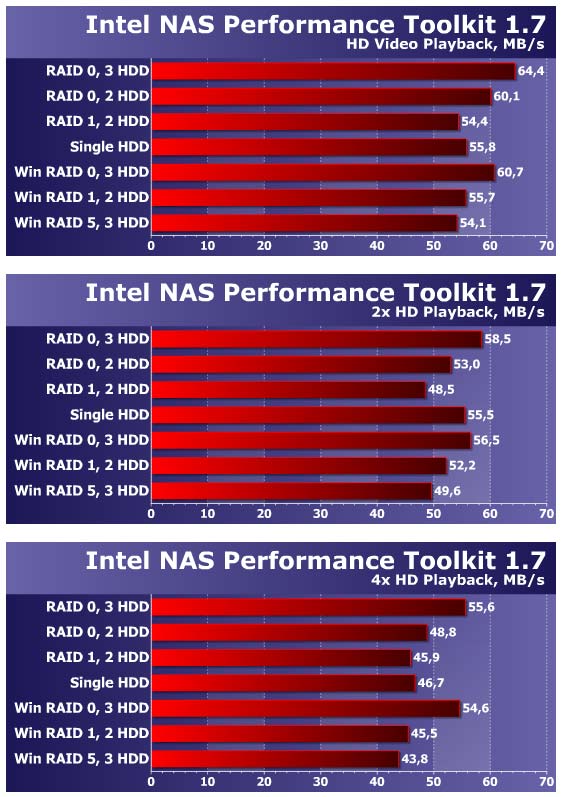
Here all arrays accurately «отранжировались» on the "internal" speed though the difference in between not so is great — about 20 % between the fastest and slowest case. Yes, the hardware arrays as a whole work a little quicker purely program, however, the difference between the same RAID here is scanty, and program "mirror" occasionally even slightly overtakes the hardware analog. It is interesting that speed for 2 and 4 flows of video falls rather one-stream case approximately for 10 and 20 % respectively that it is also possible to take for an index of good internal speed of the microserver (the truth, it still depends on applied winchesters, and with other drives the situation can change a little). As a whole about 50 MB/s in case of 4 flows of video playback — it is quite decent for a SOHO segment and the home media server (several times superimposes requests of multistream translation of Full of HD video with the highest bitrate).
And here on the scenario of record of video we face the first surprises.
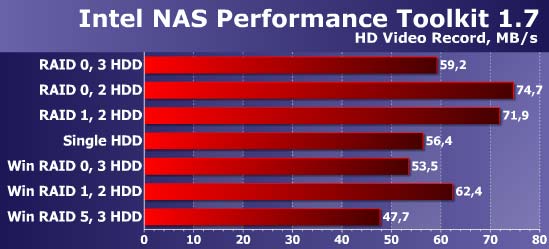
However, it is rather pleasant surprises. After all for arrays from two disks (and, both program, and the hardware RAID) speed of operation in this pattern appears explicitly above, than for three-disk arrays! We provide to readers independently to practice in guesses concerning the reasons of such unusual behavior, and we transfer to a pattern of a simultaneous read and write of video files (the digital audiotape recorder with a taymshifting, video loggers, video editing and so forth).
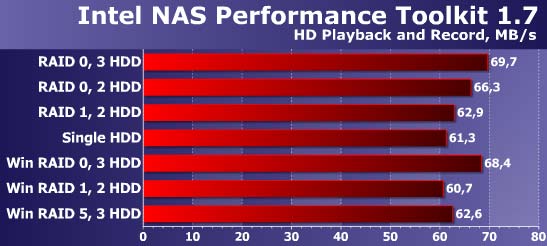
Whether here more and more repeats a pattern of multithreaded reading less, and speeds around 65 MB/s (a plus-minus of 8 %) allow not to doubt HP microserver potential especially.
Now — group of patterns of NASPT on a read and write of files and directories of the network drive.
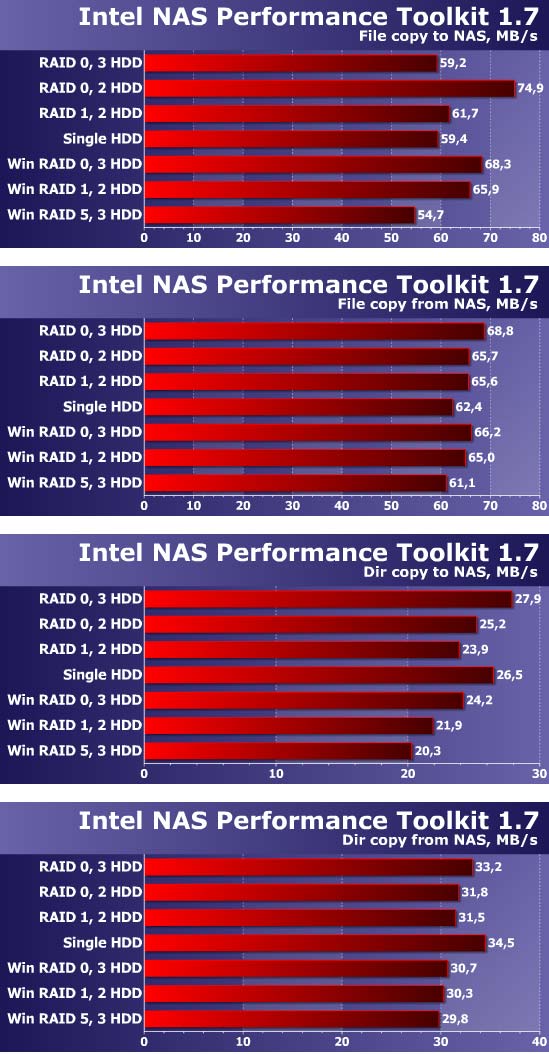
In case of record of the large file on the microserver we watch the same unexpected pattern, as in case of record of video (who would doubt) — two-disk arrays escape forward! However, if record occurs more small-sized files (the directory with a set of files), a situation returns to "reasonable" — three-disk RAID 0 nevertheless are in the lead. When reading the large file and a directory with a set of files with NAS the hardware RAID appear a little more preferably than software solutions (however, the gap in between is hardly higher than 5 %). And, on reading a directory the JBOD option (in the person of a single disk) unexpectedly advances all remaining arrays of disks! And in the light of that the gap between arrays in network tests is rather small, JBOD, instead of RAID 0, in our opinion, is optimum option of use in this case if protection of data in the person of "mirror", of course, isn't necessary. By the way, on small-sized files against large (within these scenarios NASPT) speed of operation of the HP microserver on a network will fall approximately twice.
And at last — three scenarios of complex use of network drives — creation by the network user of a multimedia content, operation with office applications and viewing/editing of the photos being on NAS. All three scenarios can be met often as on workplaces in a SOHO segment, and, perhaps, houses.
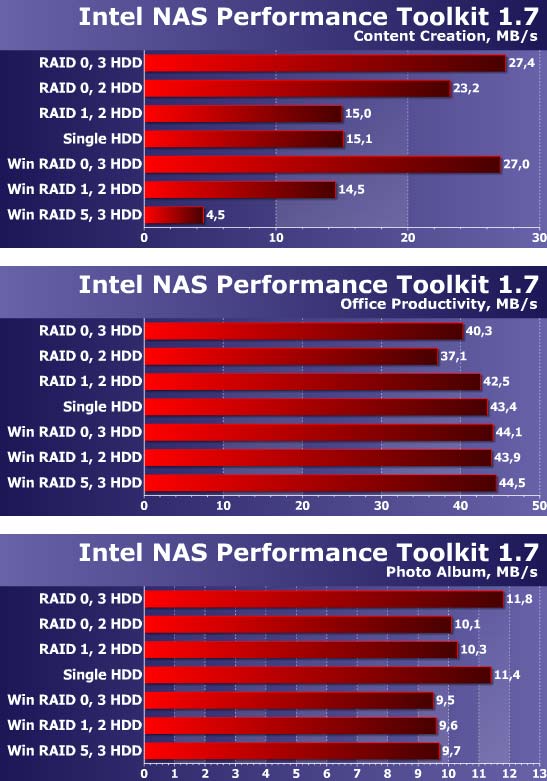
And here we are waited by some more surprises (miles sorry for an oxymoron). First, in the scenario Content Creation arrays cardinally differ till speed. Especially it concerns three-disk RAID 0 (the hardware and program options here are almost equivalent) which are in the lead with a big lift-off, and hardly live "softovy" RAID 5 (on it «rebuild» a request not to sin — the array was created nearly 40 hours and in the course of tests didn't degrade).
Opposite pattern — by office operation! Here already all arrays are equivalent till speed (and all are rather bright), and "softovy" as a whole give odds to "chipsetny". At last, in Photo Album we again see an uncommon pattern — absolute speeds of operation are low, program arrays a little more slowly, and the hardware RAID 0 (3 disks) and "odinochnik" откатались is better than all "hotbeds".
If to count «average temperature on hospital», having geometrically averaged results of all patterns of NASPT, it will appear that
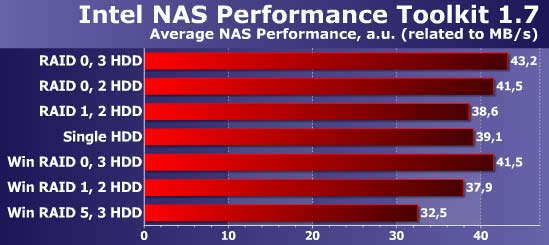
Conclusion
It is remembered, when NAS on the Intel Atom platform only started to win the market and cost very decent money (however a little, since then they fell in price), I in talk to one of big bosses to all to the known Taiwan leading company in this area, complaining about excessive high cost of their production (of which the Russian users strongly complain), advised to sell, as one of options, only the hardware of the NAS (this iron, in fact, after all not such expensive). The pier, isn't always necessary to our handymen that Linux-set, with which NASY are stuffed «on enforcement» and for which buyers more than twice overpay to rather real cost of a hardware platform, not always needing and actually without using all that functionality for which are stimulated to pay! The idea seemed to the boss rather interesting and «they promised to think». However years passed, and things are right where they started — NAS’ stubborn hold the model of sales, gathering megacream from "minisoftware".
And here rescue to the people came from there, from where for it not too waited! HP ProLiant MicroServer — it not only "golenky", «almost anything imposed» a hardware platform for creation not only smart NAS and the corporate microserver for the small company or the private house, but also rather flexible "designer" who in skillful pens can create if not miracles, then very much the useful affairs. And the cheap energy saving AMD platform here has as it is impossible by the way (though the hardware support of encoding nevertheless explicitly doesn't suffice to the processor and for обсчетов RAID 5/6 to the processor won't damage special XOR units). I do not know, whether it is possible to call this decision revolutionary (nevertheless this too loud mot), however «Original design» we adjudge our award to it with great pleasure.
If you have problems with RAID data recovery and live near Houston please contact with us.




